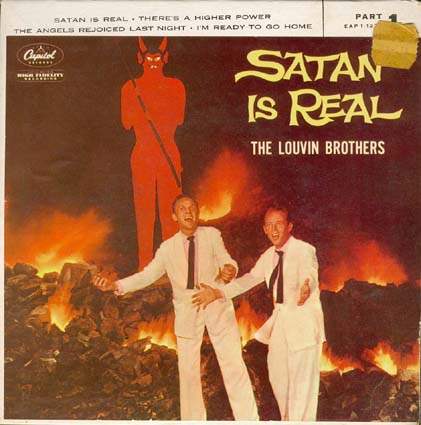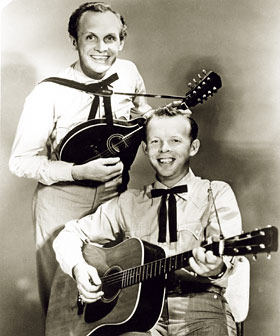by Marshall Bowden
Ira and Charlie Louvin are links between so many worlds: the sepia-toned individualism of what Greil Marcus refers to as ‘The Old, Weird America,’ the traditional country music background of performers such as Johnny Cash, the bluegrass tradition—Ira and Charlie were considered one of the best bluegrass duos at a time when Bill Monroe was already an established star—and straight into the heart of rock and roll and pop music with the success of the Everly Brothers, who modeled their work on the Louvins’ ‘close harmonies.’ They began, and first gained recognition, as a gospel recording act, and they never completely abandoned that aspect of their work even as their star rose in the mainstream country music world.
The Louvins were Elvis Presley’s favorite gospel vocal group, and they were on tour with him when Ira, who had problems with temper and alcohol, berated Presley for playing black music, calling him a ‘white nigger’ and declaring that rock music was ‘trash.’ Yet the brothers recorded powerful bluegrass-instilled gospel music that served as the blueprint for the Everley Brothers sound and influenced several generations of country music-inspired singers and songwriters. Two of their albums stand out as especially influential: Tragic Songs of Life, recorded in 1956, and Satan is Real, recorded in 1959.
In 1955 the Louvin Brothers had a top ten hit with “When I Stop Dreaming,” the first in a line of secular hits. From ’55 to 1962 they had a dozen hits on the charts, including “Cash on the Barrelhead,” “You’re Running Wild,” “How’s the World Treating You,” and “Knoxville Girl.” Ira Louvin, however, had always wanted to be a preacher, and one suspects that he paid for selling his soul with these hardscrabble religious-themed albums, but the Louvins more than likely straddled this dichotomy without discomfort. Or rather in spite of the discomfort. In the time and place—the 1940s in northeastern Alabama—that the Louvins grew up, sin and religious faith walked hand in hand. The types of sins that the Louvins preach against are those that concerned the families and neighbors with whom they grew up: drinking, not believing, drinking, drinking and driving. But there are indications of a deeper darkness at work as well.
Download or stream it
 The Louvins begin Tragic Songs of Life with a song about the beauty of Kentucky country framed as the wish of a man that his remains be buried there. It’s indicative of their approach—there is great beauty in life, but never doubt that the judgment of either God or Satan is right around the corner. Nonetheless, it is the rare listener who will remain unaffected by this song. Later the duo covers one of the great mystery songs of all time, “In the Pines. ‘In the Pines” hints at all manner of darkness and even evil, presented by the brothers’ high, harmonious whine mimicking the ‘cold wind’ that blows through the pines. One imagines a place where the boughs of pine close in above the singer and no sunlight at all reaches the forest floor. It is here that the singer comes face to face with some deepest fear or darkest moment, like Luke Skywalker in the cave on Degobah encountering himself dressed in Darth Vader’s armor. The song touches the very heart of life and the very heart of death as well. Like “Mystery Train” “In the Pines” contains the image of a ghostly train that somehow transmigrates the planes of this world and a spiritual world that is out of reach. At times the train appears and carries someone from this plane to the other.
The Louvins begin Tragic Songs of Life with a song about the beauty of Kentucky country framed as the wish of a man that his remains be buried there. It’s indicative of their approach—there is great beauty in life, but never doubt that the judgment of either God or Satan is right around the corner. Nonetheless, it is the rare listener who will remain unaffected by this song. Later the duo covers one of the great mystery songs of all time, “In the Pines. ‘In the Pines” hints at all manner of darkness and even evil, presented by the brothers’ high, harmonious whine mimicking the ‘cold wind’ that blows through the pines. One imagines a place where the boughs of pine close in above the singer and no sunlight at all reaches the forest floor. It is here that the singer comes face to face with some deepest fear or darkest moment, like Luke Skywalker in the cave on Degobah encountering himself dressed in Darth Vader’s armor. The song touches the very heart of life and the very heart of death as well. Like “Mystery Train” “In the Pines” contains the image of a ghostly train that somehow transmigrates the planes of this world and a spiritual world that is out of reach. At times the train appears and carries someone from this plane to the other.
The two albums are really companion pieces. Tragic Songs of Life is about the mean, hard world that was completely real to the Louvins. The kind of world where bitter people cling to guns and, yes, religion. Satan Is Real is about redemption of sorts. It provides the template for perhaps confronting some of the situations found on Tragic Songs of Life. One of the things that is often said regarding John Milton’s epic poem Paradise Lost is that Satan is more vividly painted, more realistic, and ultimately more likeable than God and his angels. Indeed that is the topic of the song “Satan is Real” based on the true experience that Ira had, of attending a church where an elderly man got up and told the preacher to tell his congregation that Satan was just as real as God. It’s easy to hear a song like this as ironic, until one remembers that this kind of irony, so absurdly common in our time, was rare indeed in 1956. What makes Satan is Real really scary is that fact that Ira and Charlie are neither joking nor poking fun at anything.
Nonetheless, the album cover, a photograph of an actual set the brothers designed themselves, has become famous. The large plywood Satan in the background may appear cheesy, but the pile of kerosene-soaked rocks the brothers set afire for the photo nearly injured them when some of the rocks began to explode. Despite its primitive nature, the cover is truly haunting, and so is the music within.
The brothers split up their musical act in 1964, and the following year Ira, who was a serious drinker, was killed in an automobile accident in Williamsburg, Missouri.
